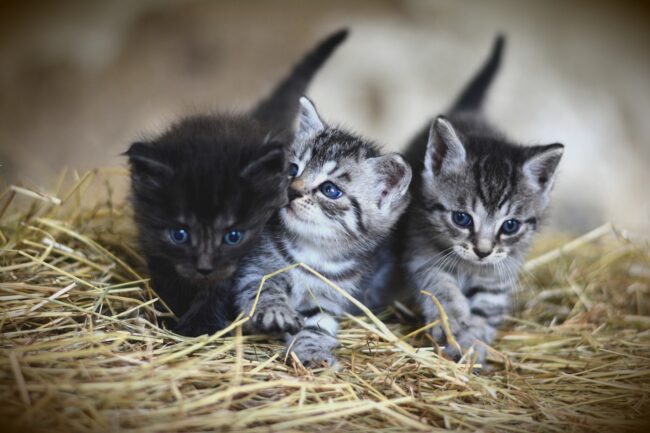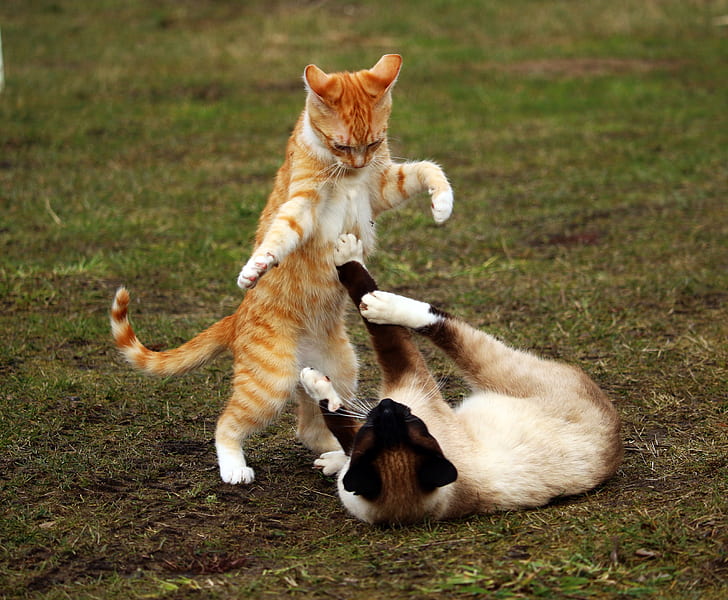Table of Contents
Considering the fact that most adult cats spend nearly half of their waking hours grooming themselves, it is safe to say that grooming is an important part of a cat’s life. But why and how do they do it? Let’s take a look and find out.
What do cats use to groom?
Cats have three grooming ‘tools’ that they use to keep themselves looking clean and tidy: their teeth, paws, and tongue. A cats tongue is barbed with ‘papillae’, and this is super useful for getting rid of dirt from their body, and pulling out any loose hairs too.
When it comes to their paws, Cats lick the insides of their front paws and then rub them across their ears and face, places that are difficult if not impossible to reach with the tongue, so the paws do what the tongue can not. Cats use their tiny front teeth to remove fleas and ticks, work mats out of their fur, and remove plant material stuck deeper in their fur than their tongues can reach.
They chew on their claws with their back teeth to remove worn claw husks and replace them with sharp, new daggers. So the teeth have a slightly different function that works with the paws and the tongue to help make grooming easy.
Why Cats Groom?
There are many reasons why cats groom themselves and one another, let’s take a look at some of the most obvious:
To Keep Clean
Cats are natural predators, so keeping themselves clean is an important way to stay undetected by their prey. Grooming helps cats remove any food residue, keep their coat clean, and stay undetected.
Friendship
Kittens start grooming one another — a behavior called allogrooming — by the time they’re five weeks old. Sometimes this behavior continues into adulthood, with bonded cats spending time grooming the places that are hard to reach by themselves. It is a great way to bond, and is a sign that your cats are close.
A Way to Relax
You’ve probably seen a cat start grooming herself after an embarrassing moment like falling off a counter. This is called a displacement behavior, relieving the stress caused by that momentary lapse of poise and grace. If a cat is severely stressed, she could resort to overgrooming or “barbering” her fur to feel better. So think of it as a spa treatment for cats, but they are giving themselves a relaxing treatment.
Grooming and playfighting
Although grooming can be seen to be a friendly and social activity, there is always going to be a line that is crossed sometimes, and if the wrong buttons are pressed, playfighting can ensue, and genuine fighting can take over in some rare instances.
Hissing, squealing, slapping, etc., can be unleashed at that point. This is where an owner must step in and make peace between the two agitated felines. A lack of patience tends to be the tipping point. This is because cats are naturally curious animals and like to walk to the beat of their drum; the act of another cat messing with them for too long can lead to irritation and force them to lash out.
Grooming followed by fighting can result from an illness or disease detection. Although rare, some cats may stumble upon a flesh wound or infection in the cat they’re grooming. Once an area (or smell) of concern has been found, this may halt grooming and take a more stern and standoff-ish approach. So if you see this occur, it may be a good idea to check in on your furry friend to see if they have any little injuries or scratches.
8 Cat Grooming Facts and Tips
Now that you have learned a little bit more about cat grooming, why it occurs, and why it is important to keep your cat healthy and happy, here are some fun facts about grooming that will only help educate you more.
- Cats will spend 30-50% of their waking hours grooming themselves!
- Grooming is actually great for a cat’s skin and can help in the production of sebum.
- Due to the fact that cats are super-flexible, they can groom almost anywhere on their bodies with ease.
- If your cat has long hair, then it will likely need a hand when it comes to efficient grooming. Persian cats, for example, need to be brushed daily to help distribute the cats natural oils.
- A lack of grooming in your cat can be a bad thing. If your cat stops grooming and starts to look dirty or matted, that can be a sign that your cat isn’t feeling well. If your cat’s grooming behavior changes dramatically, make sure you have your vet check them out for any potential health problems.
- Cats use grooming to distract themselves from a negative experience. This is called displacement behavior. A tense meeting with another cat, an embarrassing fall, and anything that causes your cat to feel anxious can lead to your cat grooming themselves to feel calmer.
- If you are going to groom your cat, then try to keep it fun. Cat grooming has to be fun for you and your feline. Grooming a cat can be a big difficulty, especially if your cat is quite opposed to the idea. But if the same becomes a regular playtime activity, she will eagerly wait for it. Involve her favorite toys and snacks to keep her busy. The rewards will assure her that grooming sessions mean a tasty treat and a good playful time. Initially, keep the grooming sessions as short as 10-15 minutes. You may gradually increase the time and process with every other session.
- If you are grooming your cat, look to try and brush her teeth as well. This will only help to keep your cats hygiene at its best.
FAQ’s
Do cats groom one another to show affection?
While not directly spread through grooming, inter-cat aggression and dominance play a role in catfights. Adult cats who share a home may groom each other as a sign of affection and bonding. Cat grooming encompasses a variety of behaviors, and we still have more to learn, but it is safe to assume that grooming could be down to affection, yes.
Why does my cat bite me after grooming?
Since grooming is a way for cats to bond, you can be fairly confident that your cats have a good relationship with one another. The biting after grooming is most likely a form of communication, a sudden change in gears from grooming to playing, or maybe it’s simply part of the grooming itself. Your cat may not just bite at you; they could also bite at the other cat or cats in your home. This is normal.
When do cats start grooming one another?
Grooming begins after a mother’s maternal instincts kick in once she has given birth. She will continue to groom her kittens until they eventually learn to groom themselves. The kittens will then learn this behaviour as they grow up and start mutual grooming with other cats.
How do cats groom themselves?
Most cats, if not all cats, will groom themselves using their ‘barbed tongue’, which easily removes dirt, dust and loose hairs from their coat.
Do cats self-groom?
This self-grooming and mutual grooming (referred to as allogrooming) continue into adulthood. Cats are flexible, strategic, and well-equipped for grooming. Everything from the rough surface of a cat’s tongue to her sharp teeth, comb-like paws, and forepaws add up to a finely tuned grooming machine.




